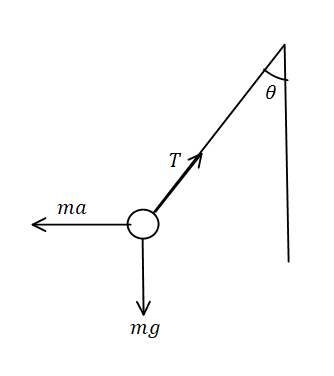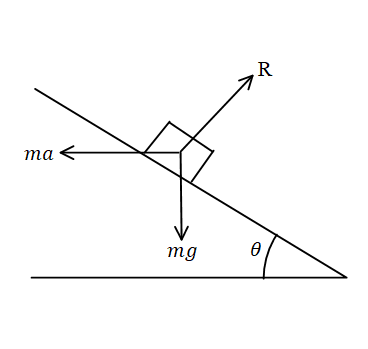
A car is speeding up on a horizontal road with an acceleration $\alpha $. Consider the following situations in the car.
(i) A ball is suspended from the ceiling through a string and is maintaining a constant angle with the vertical. Find this angle.
(ii) A block is kept on a smooth incline and does not slip on the incline. Find the angle of the incline with the horizontal.
Answer
216.3k+ views
Hint: The equations formed by the free body diagram can be used to make equations and by solving these equations we can solve this problem. The constant acceleration of the car will make the suspended ball to make an angle $\theta $ with the vertical.
Complete step by step solution:
(i) It is given in the problem that a bob of mass m is suspended in the car which is accelerating with the acceleration $\alpha $ and we need to find the angle of the bob with vertical.

From the above free body diagram.
In the vertical direction,
$ \Rightarrow T\cos \theta = mg$
$ \Rightarrow T = \dfrac{{mg}}{{\cos \theta }}$………eq. (1)
Also,
In the horizontal direction,
$ \Rightarrow T\sin \theta = ma$
$ \Rightarrow T = \dfrac{{ma}}{{\sin \theta }}$………eq. (2)
Equating the tension from equation (1) and equation (2) we get.
$ \Rightarrow \dfrac{{mg}}{{\cos \theta }} = \dfrac{{ma}}{{\sin \theta }}$
$ \Rightarrow \dfrac{g}{{\cos \theta }} = \dfrac{a}{{\sin \theta }}$
$ \Rightarrow \dfrac{{\sin \theta }}{{\cos \theta }} = \dfrac{a}{g}$
$ \Rightarrow \tan \theta = \dfrac{a}{g}$
$ \Rightarrow \theta = {\tan ^{ - 1}}\dfrac{a}{g}$.
(ii) The angle of the bob with the string which is inside the car makes and angle $\theta $ with the vertical is equal to, $\theta = {\tan ^{ - 1}}\dfrac{a}{g}$.
Now let the angle of the inclination of the inclined plane be $\phi $.

From the above free body diagram,
In the direction perpendicular to the inclined plane.
$ \Rightarrow ma\cos \phi = mg\sin \phi $
$ \Rightarrow a\cos \phi = g\sin \phi $
$ \Rightarrow \dfrac{{\sin \phi }}{{\cos \phi }} = \dfrac{a}{g}$
$ \Rightarrow \tan \phi = \dfrac{a}{g}$
$ \Rightarrow \phi = {\tan ^{ - 1}}\dfrac{a}{g}$
The angle of inclination is given by$\phi = {\tan ^{ - 1}}\dfrac{a}{g}$.
The angle of the bob with vertical which is inside the car is equal to $\theta = {\tan ^{ - 1}}\dfrac{a}{g}$ and the angle of inclination of the smooth inclined plane is equal to $\phi = {\tan ^{ - 1}}\dfrac{a}{g}$.
Note: The bob experiences the forces on the backwards as the response of the acceleration of the car and at the equilibrium position it holds making an angle $\theta $ .The tension in the string always acts away from the body. The acceleration of the car is in the horizontal direction and the weight of the car is in the vertically downward direction.
Complete step by step solution:
(i) It is given in the problem that a bob of mass m is suspended in the car which is accelerating with the acceleration $\alpha $ and we need to find the angle of the bob with vertical.

From the above free body diagram.
In the vertical direction,
$ \Rightarrow T\cos \theta = mg$
$ \Rightarrow T = \dfrac{{mg}}{{\cos \theta }}$………eq. (1)
Also,
In the horizontal direction,
$ \Rightarrow T\sin \theta = ma$
$ \Rightarrow T = \dfrac{{ma}}{{\sin \theta }}$………eq. (2)
Equating the tension from equation (1) and equation (2) we get.
$ \Rightarrow \dfrac{{mg}}{{\cos \theta }} = \dfrac{{ma}}{{\sin \theta }}$
$ \Rightarrow \dfrac{g}{{\cos \theta }} = \dfrac{a}{{\sin \theta }}$
$ \Rightarrow \dfrac{{\sin \theta }}{{\cos \theta }} = \dfrac{a}{g}$
$ \Rightarrow \tan \theta = \dfrac{a}{g}$
$ \Rightarrow \theta = {\tan ^{ - 1}}\dfrac{a}{g}$.
(ii) The angle of the bob with the string which is inside the car makes and angle $\theta $ with the vertical is equal to, $\theta = {\tan ^{ - 1}}\dfrac{a}{g}$.
Now let the angle of the inclination of the inclined plane be $\phi $.

From the above free body diagram,
In the direction perpendicular to the inclined plane.
$ \Rightarrow ma\cos \phi = mg\sin \phi $
$ \Rightarrow a\cos \phi = g\sin \phi $
$ \Rightarrow \dfrac{{\sin \phi }}{{\cos \phi }} = \dfrac{a}{g}$
$ \Rightarrow \tan \phi = \dfrac{a}{g}$
$ \Rightarrow \phi = {\tan ^{ - 1}}\dfrac{a}{g}$
The angle of inclination is given by$\phi = {\tan ^{ - 1}}\dfrac{a}{g}$.
The angle of the bob with vertical which is inside the car is equal to $\theta = {\tan ^{ - 1}}\dfrac{a}{g}$ and the angle of inclination of the smooth inclined plane is equal to $\phi = {\tan ^{ - 1}}\dfrac{a}{g}$.
Note: The bob experiences the forces on the backwards as the response of the acceleration of the car and at the equilibrium position it holds making an angle $\theta $ .The tension in the string always acts away from the body. The acceleration of the car is in the horizontal direction and the weight of the car is in the vertically downward direction.
Recently Updated Pages
JEE Atomic Structure and Chemical Bonding important Concepts and Tips

JEE Amino Acids and Peptides Important Concepts and Tips for Exam Preparation

Electricity and Magnetism Explained: Key Concepts & Applications

Chemical Properties of Hydrogen - Important Concepts for JEE Exam Preparation

JEE Energetics Important Concepts and Tips for Exam Preparation

JEE Isolation, Preparation and Properties of Non-metals Important Concepts and Tips for Exam Preparation

Trending doubts
JEE Main 2026: Application Form Open, Exam Dates, Syllabus, Eligibility & Question Papers

JEE Main Correction Window 2026 Session 1 Dates Announced - Edit Form Details, Dates and Link

Derivation of Equation of Trajectory Explained for Students

Hybridisation in Chemistry – Concept, Types & Applications

Understanding the Angle of Deviation in a Prism

Understanding Collisions: Types and Examples for Students

Other Pages
JEE Advanced Marks vs Ranks 2025: Understanding Category-wise Qualifying Marks and Previous Year Cut-offs

Units And Measurements Class 11 Physics Chapter 1 CBSE Notes - 2025-26

NCERT Solutions For Class 11 Physics Chapter 8 Mechanical Properties Of Solids

Motion in a Straight Line Class 11 Physics Chapter 2 CBSE Notes - 2025-26

NCERT Solutions for Class 11 Physics Chapter 7 Gravitation 2025-26

How to Convert a Galvanometer into an Ammeter or Voltmeter




